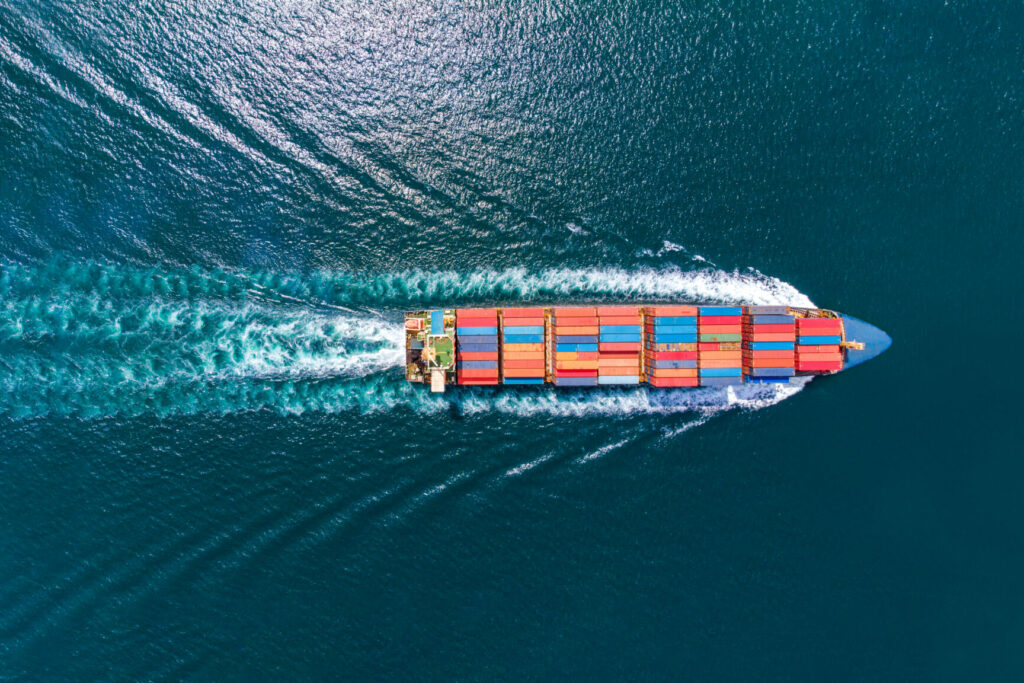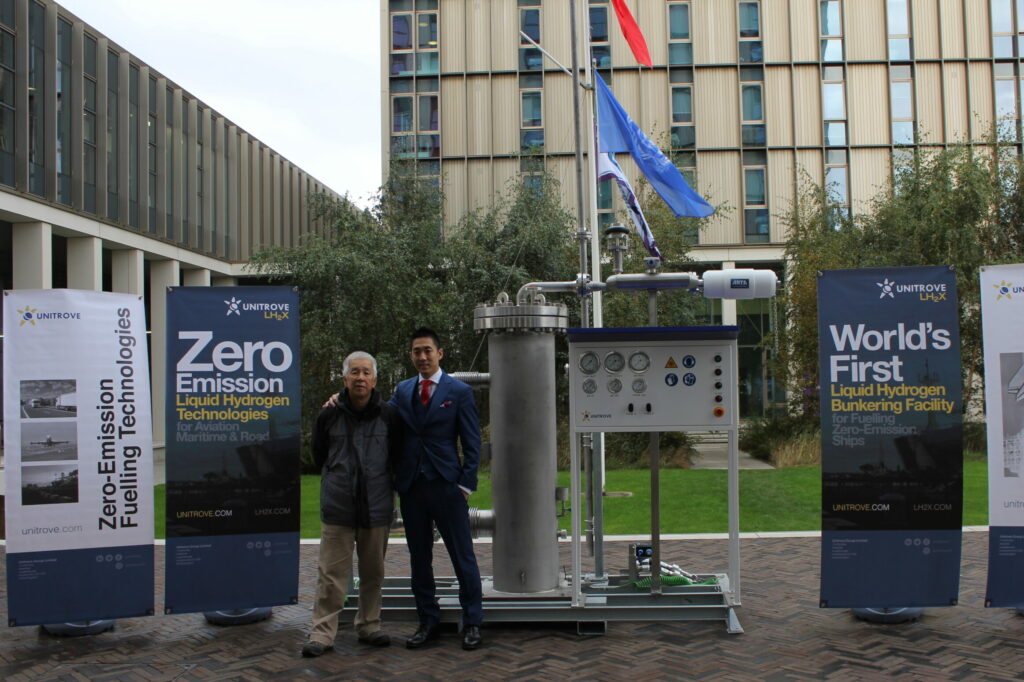
A year ago, a ship got stuck in the Suez Canal, and the world stopped.
Although it may seem that ships are a thing from the past, the global economy is still incredibly dependent on this mode of transportation. It is estimated that 90% of the world’s goods are transported by the international shipping industry, including food, raw materials, and manufactured goods. This comes at a cost: Overall, the shipping sector is considered to be responsible for 3% of all global greenhouse emissions, almost double the impact of the aviation industry.
The environmental impact of shipping also has severe consequences for global health. The fine particulate matter, sulphur oxides and nitrogen oxides that this industry produces are a fundamental contributor to around 400,000 premature deaths and 14 million cases of childhood asthma every year.
But despite the massive global dependency on this industry and its huge impact on the health of humans and the planet, there hasn’t been a large demand to decarbonise ships in the same way that there has been for cars or planes. Steven Lua, CEO of Unitrove, wants to change this.
“The global maritime sector is one of the most polluting in the world,” he says. “It’s estimated that just a handful of the worst-polluting mega-ships on our oceans today produce more pollution than all the world’s cars put together. That’s a staggering statistic, and one we simply cannot ignore. My personal mission is to create a virtuous world for the next thousand generations.”
Lua created Unitrove in order to provide clean, affordable energy solutions. Although the company was initially focused on decarbonising the heavy-duty transport industry, it turned to ships after building the UK’s first natural gas-fuelled facility in the Teesside area, in the north-east of England. It was then that Lua realised the massive carbon footprint of mega-ships and the industry’s dire need for decarbonising solutions.
The global maritime sector is one of the most polluting in the world.
However, natural gas was still a fossil fuel, and although it presented a great start, it wasn’t an ideal solution long-term. Enter liquid hydrogen.
Last year, during COP26, Unitrove presented the world’s first liquid hydrogen bunkering unit, which can be used to fuel zero-emission ships. The project was a collaboration with Maritime UK – the industry body for the £46bn UK maritime sector – and it was presented at the Riverside College of the University of Glasgow as having enormous potential for many uses, including bridging the gap where electric and compressed hydrogen cannot reach: large vessels.
“A lot of the shipping industry at the moment that is looking at hydrogen are using what they call ‘compressed hydrogen’, which is good for small boats and things like that,” Lua says. “What we’ve decided to do is to take hydrogen but liquefy it, so it ends up being a gas at -253°C.”

“Ultimately, we take road tankers full of this stuff, and we connect it to our facility – think of it as a black box – and we then connect our facility to a ship. Then the ship will be able to take the contents of the fuel from the road tanker or the container into the fuel tank. By doing that, we’re able to deliver a lot more fuel in a compact space relative to other fuels.”
From a volumetric energy density point of view, hydrogen is very large, which is a big problem for shipowners who are used to managing fuels that are heavy and dense and can be stored in small containers. Liquifying hydrogen, therefore, can change the rules of the game.
Although liquid hydrogen might sound incredibly futuristic, it isn’t. It has been used for decades as the propulsion fuel of choice for launching rockets and satellites into space. Lua compares it to electricity: it has been around for centuries, but we only started using electric cars a few years ago.
“Actually, some of the technologies that we are using in our unit will be coming from the space programmes,” he explains. “For example, the building connector that we need to connect between the road tanker and our unit is using what they call the Air Force company, presumably from the American Air Force standards, which was coming from NASA. We’re ultimately using technologies that have already been existing for the past 60 years or so, and we are just putting them into a brand-new context.
“So, for those people that are worried and saying that this is a new technology, we’re saying: ‘No, this is not new technology. It’s a new market for existing technology.’”
However, decarbonising the shipping industry goes beyond individual ships. In order for these ships to function there has to be a network and infrastructure that supports clean fuels. This is why the creation of a liquid hydrogen bunkering unit is so vital to the industry.
Despite Lua’s excitement about the impact that liquid hydrogen bunkering units will have on the world, and the environmental footprint of the global economy, he recognises it isn’t something that initially excites many people or that is often discussed in conversations about the net-zero goals.
“People don’t tend to see shipping,” he says. “It tends to be in the shadows of everything else. From the governance perspective, they focus a lot on decarbonising cars, vans, trains, planes, buses, etc – things that the public can see. If you look at where the excitement is, people look at the Tesla car and say ‘This is the future of transport.’ And when you mention ‘We’ve just reinvented the petrol station’, it doesn’t quite have the same ring to it.”
The UK government has recently promised to introduce the first generation of zero-emissions ships in four years’ time to support its goal of achieving net-zero by 2050. In April 2021, the UK decided to include its share of international shipping and aviation emissions in its sixth Carbon Budget after decades of only counting emissions that were produced within its borders, a decision that had drawn criticism from green groups.
However, in Lua’s view these plans, although exciting, are leaving a fundamental part out: the infrastructure needed to support those ships, from bunkering units to the laws around the import and export of hydrogen.

“I am a bit concerned that the governments are not looking close enough to the fueling infrastructure side of things,” he says. “If they don’t decide to put their money in the infrastructure side of things, and they spend all their money in the downstream technologies, then you’re not going to be able to grow that because then there’s no way for the ecosystem to flourish. Without the infrastructure, we’re not going to have these vehicles.”
“One of the interesting questions I asked the ICS [International Chamber of Shipping] was: ‘What is the thinking and strategy around the import and export of hydrogen?’ And they said: ‘We’ve not really thought about that.’ I think we’d better because let’s say you’re located in Scotland, you’re building a wind turbine and you’re producing green hydrogen. If you produce green hydrogen quite often, what you’ll get out of the end of that process is a very low-pressure potion, which is great, but it’s not very good for just transporting in that mode.”
If the whole shipping industry is to run on hydrogen in a few decades, it is vital to devise effective ways to transport and commercialise the element. With this goal in mind, Unitrove is looking at options including ammonia, liquid organic hydrogen carriers and solid hydrogen in the form of sodium borohydride, some of which have already started to be used in countries such as Qatar.
The importance of regulating the import and export of hydrogen is not the only topic in which Lua disagrees with the ICS. The other one is its timelines. At the moment, the ICS has pledged to make 50% of its industry zero emissions by 2050, a much less ambitious goal than many other countries and industries and one that is not compatible with the Paris Agreement, which has called for fully zero-emissions by 2050.
Moreover, a factor that many of these timelines often forget is the lasting duration of the infrastructure. A large commercial ship, for example, can last up to 40 years, and so the ships that are being built today would still be functioning in 2060. Therefore, the need for zero-emission ships is more urgent than ever.
“We have to at least start at the minimum, and then work our way backwards,” Lua says. “Now that we’ve made the statement that the technology exists, we’ve got the next 15 years left to make decisions around our shipping fleet and to renew that.
“It is sensible to align with that because the longer they [the international shipping industry] take to decide to align with that, the more the spotlight will shine on them. And the shipping industry definitely doesn’t want the spotlight shining on them. Because that is the thing that is going to unravel the whole industry, which has been operating for a very long time under the guise of the lack of transparency, even more so than probably a lot of the other industries.”
The regulations of the shipping industry are often murky waters. Many companies are private and their ships operate under different territories from the country the company belongs to, making accountability much more difficult to establish.
However, some private companies are filling regulatory gaps and taking responsibility for reducing the emissions of the international shipping industry. For example, in June 2018, the main actors from the financial sector and the shipping industry signed the Poseidon Principles to ensure that ship finance portfolios are aligned with the targets set out in the International Maritime Organization’s Initial Greenhouse Gas Strategy. Moreover, last October, nine big companies including Amazon, Ikea, and Unilever signed up to a pledge to only move cargo on ships using zero-carbon fuel by 2040.
By making access to financing conditional upon compliance with these targets, the finance industry has issued a wake-up call to the shipping sector, one they cannot sail away from.
Now that we've made the statement that the technology exists, we've got the next 15 years left to make decisions around our shipping fleet and to renew that”
“That’s a market-led signal, from within the industry,” Lua says. “This is not being forced upon them. But I feel that this has come from the transparency pressures that they’re under as big companies that the public interface with. “By these organisations coming out and making statements of intention, it is quite clear that the shipping industry will have to adapt to these needs. That will clearly change the narrative around whether they are able to continue business as usual.”
Unitrove is already answering that market demand for greener shipping solutions and collaborating with companies that are looking to build lasting green ships. The bunkering unit is Lua’s starting point, but he has much greater ambitions for liquid hydrogen infrastructure, which could include artificial intelligence technology and smart solutions. “If I were to give a hint as to where we see ourselves going, I’d say: ‘If Apple had reinvented the petrol station, what would it look like?’ That’s kind of where we see ourselves going,” Lua says. “Could we be seeing autonomous infrastructures? Very possibly.”
The shipping industry needs to be a protagonist of efforts to decarbonise the global economy, as it constitutes one of its key players. Liquid hydrogen could become the green fuel of the future, and help a very traditional sector take vital steps towards net-zero. However, in order to see zero-emission ships sailing the seas, the behind-the-scenes infrastructure needs to be put in place and regulated. It may not be as glamorous as autonomous cars, but it will protect the Earth from becoming a sinking ship.


